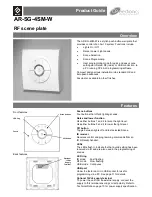
Figure 33-3. SPI Transfer Modes
Bit 1
Bit 6
LSB
MSB
Mode 0
SAMPLE I
MOSI/MISO
CHANGE 0
MOSI PIN
CHANGE 0
MISO PIN
Mode 2
SS
MSB
LSB
Bit 6
Bit 1
Bit 5
Bit 2
Bit 4
Bit 3
Bit 3
Bit 4
Bit 2
Bit 5
MSB first (DORD = 0)
LSB first (DORD = 1)
Mode 1
SAMPLE I
MOSI/MISO
CHANGE 0
MOSI PIN
CHANGE 0
MISO PIN
Mode 3
SS
MSB
LSB
Bit 6
Bit 1
Bit 5
Bit 2
Bit 4
Bit 3
Bit 3
Bit 4
Bit 2
Bit 5
Bit 1
Bit 6
LSB
MSB
MSB first (DORD = 0)
LSB first (DORD = 1)
33.6.2.6. Transferring Data
Master
In master mode (CTRLA.MODE=0x3), when Master Slave Enable Select (CTRLB.MSSEN) is ‘1’,
hardware will control the SS line.
When Master Slave Select Enable (CTRLB.MSSEN) is '0', the SS line must be configured as an output.
SS can be assigned to any general purpose I/O pin. When the SPI is ready for a data transaction,
software must pull the SS line low.
When writing a character to the Data register (DATA), the character will be transferred to the shift register.
Once the content of TxDATA has been transferred to the shift register, the Data Register Empty flag in the
Interrupt Flag Status and Clear register (INTFLAG.DRE) will be set. And a new character can be written
to DATA.
Each time one character is shifted out from the master, another character will be shifted in from the slave
simultaneously. If the receiver is enabled (CTRLA.RXEN=1), the contents of the shift register will be
transferred to the two-level receive buffer. The transfer takes place in the same clock cycle as the last
Atmel SAM L22G / L22J / L22N [DATASHEET]
Atmel-42402E-SAM L22G / L22J / L22N_Datasheet_Complete-07/2016
651
















































